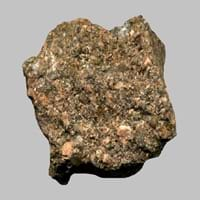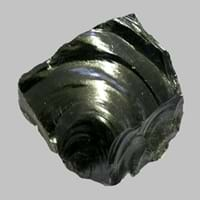Arkose and Obsidian
Definition
Definition
Arkose is a sedimentary rock, specifically a type of sandstone containing at least 25% feldspar
Obsidian is a naturally occurring volcanic glass formed as an extrusive igneous rock. It is produced when felsic lava extruded from a volcano cools rapidly with minimum crystal growth
History
Origin
France
Ethiopia
Discoverer
Alexandre Brongniart
Obsius
Etymology
From Auvergne region of France used by a French geologist Alexandre Brongniart in 1826 who applied this term to some feldspathic sandstones
From Latin obsidianus, misprint of Obsianus (lapis) (stone) of Obsius
Class
Sedimentary Rocks
Igneous Rocks
Sub-Class
Durable Rock, Hard Rock
Durable Rock, Medium Hardness Rock
Family
Group
Not Applicable
Volcanic
Other Categories
Coarse Grained Rock, Opaque Rock
Opaque Rock
Texture
Texture
Clastic
Glassy
Color
Reddish Brown
Black, Blue, Brown, Green, Orange, Red, Tan, Yellow
Maintenance
Less
Less
Durability
Durable
Durable
Water Resistant
Yes
Yes
Scratch Resistant
Yes
Yes
Stain Resistant
Yes
No
Wind Resistant
No
No
Acid Resistant
Yes
No
Appearance
Rough and Dull
Shiny
Uses
Architecture
Interior Uses
Decorative Aggregates, Homes, Interior Decoration
Decorative Aggregates, Interior Decoration
Exterior Uses
Paving Stone, Office Buildings
Garden Decoration
Other Architectural Uses
Whetstones
Not Yet Used
Industry
Construction Industry
Cement Manufacture, Construction Aggregate, for Road Aggregate, Production of Glass and Ceramics, Raw material for the manufacture of mortar
Arrowheads, Cutting Tool, Knives, Scrapers, Spear Points
Medical Industry
Not Yet Used
Surgery
Antiquity Uses
Artifacts, Sculpture, Small Figurines
Artifacts, Jewellery
Other Uses
Commercial Uses
In aquifers, Soil Conditioner, Source of Magnesia (MgO), Tombstones
Creating Artwork, Mirror, Used in aquariums
Types
Types
Not Available
Fireworks Obsidian, Mahogany, Sheen Obsidian, Snowflake obsidian and Velvet Peacock Obsidian
Features
Available in Lots of Colors and Patterns, Generally rough to touch, Is one of the oldest rock
Blocks negativity, Helps to protect against depression
Archaeological Significance
Monuments
Not Yet Used
Not Yet Used
Famous Monuments
Not Applicable
Not Applicable
Sculpture
Used
Not Yet Used
Famous Sculptures
Data Not Available
Not Applicable
Pictographs
Not Used
Used
Petroglyphs
Not Used
Used
Figurines
Used
Not Yet Used
Fossils
Present
Absent
Formation
Formation
Arkose rock forms from the weathering of feldspar-rich igneous or metamorphic rock, most commonly granitic rocks, which are primarily composed of quartz and feldspar.
When the lava is released from volcano, it undergoes a very rapid cooling which freezes the mechanisms of crystallization. The result is a volcanic glass with a uniform smooth texture.
Composition
Mineral Content
Calcite, Clay, Clay Minerals, Feldspar, Micas, Quartz
Not Available
Compound Content
Aluminium Oxide, CaO, Iron(III) Oxide, Potassium Oxide, MgO, Sodium Oxide, Silicon Dioxide
Aluminium Oxide, CaO, Iron(III) Oxide, FeO, Potassium Oxide, MgO, MnO, Sodium Oxide, Phosphorus Pentoxide, Silicon Dioxide, Titanium Dioxide
Transformation
Metamorphism
No
Yes
Types of Metamorphism
Not Applicable
Burial Metamorphism, Cataclastic Metamorphism, Contact Metamorphism
Weathering
Yes
Yes
Types of Weathering
Biological Weathering, Chemical Weathering, Mechanical Weathering
Biological Weathering, Chemical Weathering, Mechanical Weathering
Erosion
Yes
Yes
Types of Erosion
Coastal Erosion, Glacier Erosion, Water Erosion, Wind Erosion
Chemical Erosion, Coastal Erosion, Glacier Erosion
Properties
Physical Properties
Hardness
6-7
5-5.5
Grain Size
Coarse Grained
Not Applicable
Fracture
Conchoidal
Conchoidal
Streak
White
White
Porosity
Highly Porous
Very Less Porous
Luster
Dull
Vitreous
Compressive Strength
Not Available
0.15 N/mm2
33
Cleavage
Not Available
Non-Existent
Toughness
Not Available
Not Available
Specific Gravity
0
2.6-2.7
Transparency
Opaque
Translucent
Density
Not Available
2.6 g/cm3
Thermal Properties
Specific Heat Capacity
Not Available
0.92 kJ/Kg K
10
Resistance
Heat Resistant, Impact Resistant, Pressure Resistant
Heat Resistant, Impact Resistant
Reserves
Deposits in Eastern Continents
Asia
China, India, Kazakhstan, Mongolia, Russia, Uzbekistan
Afghanistan, Indonesia, Japan, Russia
Africa
Namibia, Nigeria, South Africa
Kenya
Europe
Austria, Denmark, Germany, Great Britain, Netherlands, Norway, Poland, Sweden, Switzerland, United Kingdom
Greece, Hungary, Iceland, Italy, Turkey
Others
Greenland
Not Yet Found
Deposits in Western Continents
North America
Canada, USA
Canada, Mexico, USA
South America
Brazil
Argentina, Chile, Ecuador, Peru
Deposits in Oceania Continent
Australia
New South Wales, New Zealand
New Zealand
All about Arkose and Obsidian Properties
Know all about Arkose and Obsidian properties here. All properties of rocks are important as they define the type of rock and its application. Arkose belongs to Sedimentary Rocks while Obsidian belongs to Igneous Rocks.Texture of Arkose is Clastic whereas that of Obsidian is Glassy. Arkose appears Rough and Dull and Obsidian appears Shiny. The luster of Arkose is dull while that of Obsidian is vitreous. Arkose is available in reddish brown colors whereas Obsidian is available in black, blue, brown, green, orange, red, tan, yellow colors. The commercial uses of Arkose are in aquifers, soil conditioner, source of magnesia (mgo), tombstones and that of Obsidian are creating artwork, mirror, used in aquariums.
|
||
|
||
|










